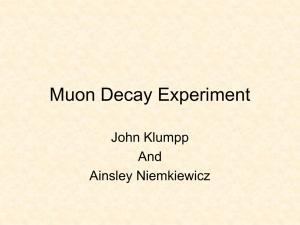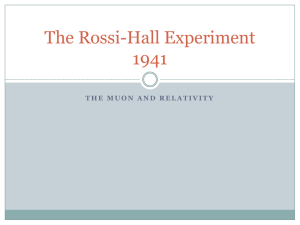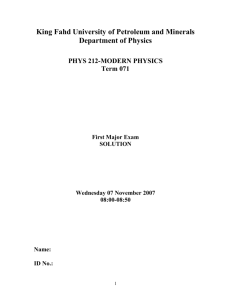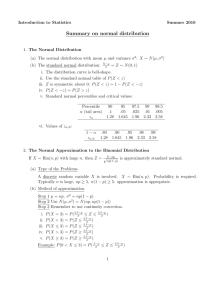Quarks to Cosmos, PHYS 125
advertisement
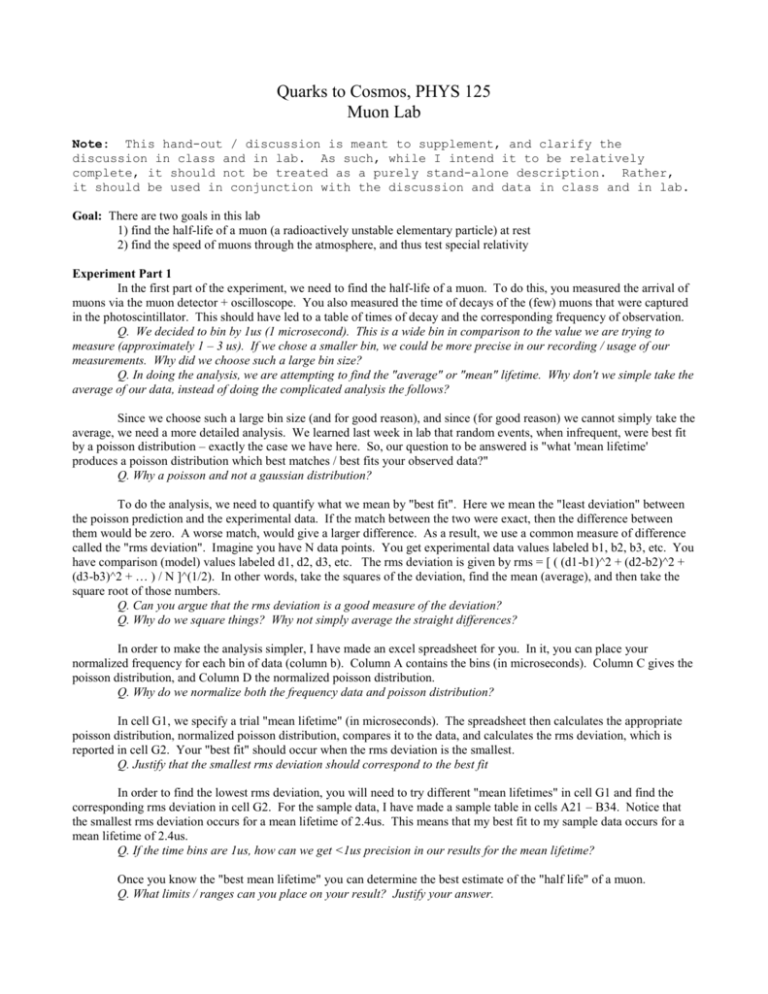
Quarks to Cosmos, PHYS 125 Muon Lab Note: This hand-out / discussion is meant to supplement, and clarify the discussion in class and in lab. As such, while I intend it to be relatively complete, it should not be treated as a purely stand-alone description. Rather, it should be used in conjunction with the discussion and data in class and in lab. Goal: There are two goals in this lab 1) find the half-life of a muon (a radioactively unstable elementary particle) at rest 2) find the speed of muons through the atmosphere, and thus test special relativity Experiment Part 1 In the first part of the experiment, we need to find the half-life of a muon. To do this, you measured the arrival of muons via the muon detector + oscilloscope. You also measured the time of decays of the (few) muons that were captured in the photoscintillator. This should have led to a table of times of decay and the corresponding frequency of observation. Q. We decided to bin by 1us (1 microsecond). This is a wide bin in comparison to the value we are trying to measure (approximately 1 – 3 us). If we chose a smaller bin, we could be more precise in our recording / usage of our measurements. Why did we choose such a large bin size? Q. In doing the analysis, we are attempting to find the "average" or "mean" lifetime. Why don't we simple take the average of our data, instead of doing the complicated analysis the follows? Since we choose such a large bin size (and for good reason), and since (for good reason) we cannot simply take the average, we need a more detailed analysis. We learned last week in lab that random events, when infrequent, were best fit by a poisson distribution – exactly the case we have here. So, our question to be answered is "what 'mean lifetime' produces a poisson distribution which best matches / best fits your observed data?" Q. Why a poisson and not a gaussian distribution? To do the analysis, we need to quantify what we mean by "best fit". Here we mean the "least deviation" between the poisson prediction and the experimental data. If the match between the two were exact, then the difference between them would be zero. A worse match, would give a larger difference. As a result, we use a common measure of difference called the "rms deviation". Imagine you have N data points. You get experimental data values labeled b1, b2, b3, etc. You have comparison (model) values labeled d1, d2, d3, etc. The rms deviation is given by rms = [ ( (d1-b1)^2 + (d2-b2)^2 + (d3-b3)^2 + … ) / N ]^(1/2). In other words, take the squares of the deviation, find the mean (average), and then take the square root of those numbers. Q. Can you argue that the rms deviation is a good measure of the deviation? Q. Why do we square things? Why not simply average the straight differences? In order to make the analysis simpler, I have made an excel spreadsheet for you. In it, you can place your normalized frequency for each bin of data (column b). Column A contains the bins (in microseconds). Column C gives the poisson distribution, and Column D the normalized poisson distribution. Q. Why do we normalize both the frequency data and poisson distribution? In cell G1, we specify a trial "mean lifetime" (in microseconds). The spreadsheet then calculates the appropriate poisson distribution, normalized poisson distribution, compares it to the data, and calculates the rms deviation, which is reported in cell G2. Your "best fit" should occur when the rms deviation is the smallest. Q. Justify that the smallest rms deviation should correspond to the best fit In order to find the lowest rms deviation, you will need to try different "mean lifetimes" in cell G1 and find the corresponding rms deviation in cell G2. For the sample data, I have made a sample table in cells A21 – B34. Notice that the smallest rms deviation occurs for a mean lifetime of 2.4us. This means that my best fit to my sample data occurs for a mean lifetime of 2.4us. Q. If the time bins are 1us, how can we get <1us precision in our results for the mean lifetime? Once you know the "best mean lifetime" you can determine the best estimate of the "half life" of a muon. Q. What limits / ranges can you place on your result? Justify your answer. Experiment Part 2 In the second part of the experiment, we need to find the speed of the muons. As we discussed in class, if relativity does not hold, then the muons should essentially all decay. Q. Justify this, and determine what fraction of the muons should decay if special relativity does not hold We counted the rate at which muons arrived in Olin at sea level. Compare this rate to the experimental value of 1 muon cm-2 s-1. Q. What fraction of the muons actually decayed? Knowing the fraction of muons that decayed, we can determine how many half lives the muons experienced. Q. Write down / derive a general expression relating the fraction left to the number of half-lives experienced Q. Solve the above expression for number of half-lives experienced Q. Plug in your results, and determine the number of half-lives experienced by the muons Knowing the number of half lives experienced, we can utilize the half-life data from Part 1 of the experiment to answer the question of how much time elapsed for the muon as it went through the atmosphere. Q. Find the time the muon experienced going through the atmosphere Now, we can do some relativity Q. Compare the time the muon experienced to the time expected without relativity Q. Find the speed of the muon, in terms of the speed of light. Q. Is there are range of speeds that your data would allow? Assumptions We will assume that the atmosphere is 10km thick, that the muons travel straight down through the atmosphere, that none enter through the sides of the muon detector, and that the muons travel near the speed of light (though you are testing this last one). Final Note The questions above are probably not the only ones you should be considering. However, they are a natural example of the types of things that help to answer the lab goals, to justify our results, and should be asked by a critical thinking person. I am sure that there are others that you might want to incorporate.
